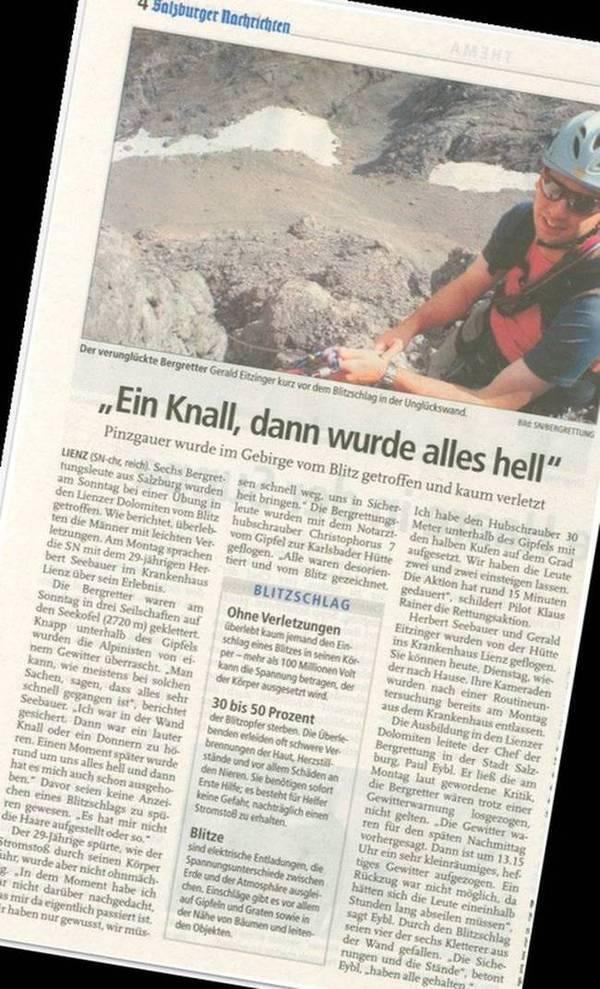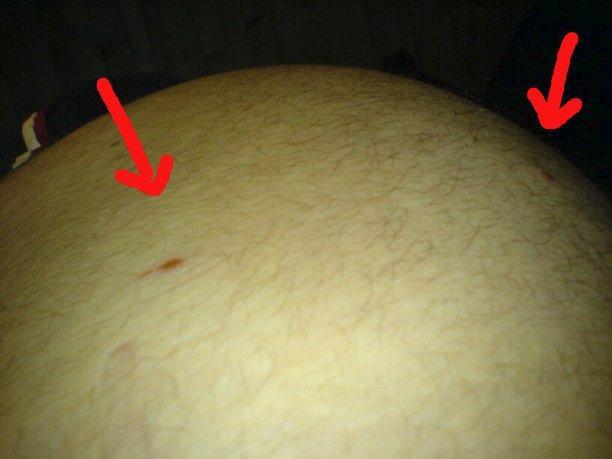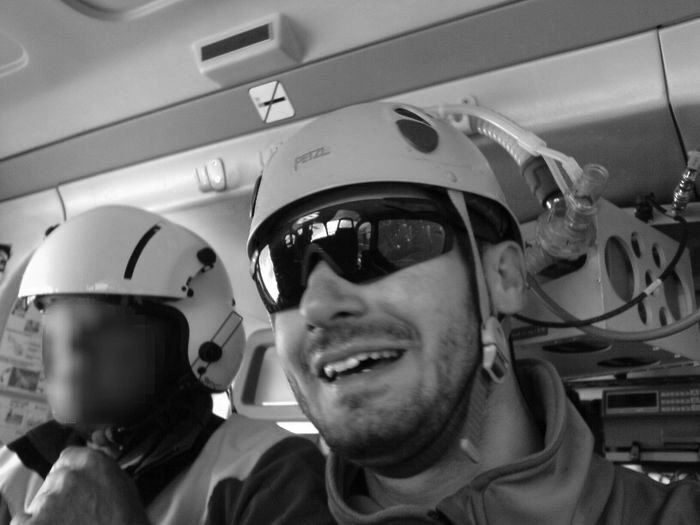Accident in the Alps: Like being hit with a bat - and the confusion afterwards
How you react when something totally unexpected happens and when you think your life is on the line. And some lessons learned on first aid in a mountainous environment as well.
Back in July 2006 I was training with the Austrian Mountain Rescue in the Dolomite Alps.
Being a medical student and EMT at the time, I was eager to learn about rescue in the mountains and hopefully put my knowledge to work soon. I had recently done the step from outdoor climbing on bolted routes to traditional climbing with hexes, friends and pegs. Despite you work in a rescue environment, that doesn’t mean that you actually use these techniques, especially in times of Hilti, expansion bolts and specialized rescue equipment.
We planned a multi pitch climb that was supposed to end at a local top just above 2700m some time around the early afternoon. Stable weather predictions, and nice weather can be seen in pictures taken during the climb. There were thunderstorms predicted for the late afternoon, which is very common throughout the Alps during summertime. Hence our decision to be finished with the climb long before then.
The climb went well, we were three rope teams, 2 climbers each. Me being part of the first team, we looked for a way down just when we finished close to the summit after our last pitch. So we took off our ropes and let the next team use the stand.
Suddenly strong winds and hail set in. Looking toward the edge of the high cliff where the lead of team nr 2 was appearing over the edge, I suddenly experienced what felt like being hit with a baseball bat in the lower back. It knocked the air out of me. At the same time I saw my climbing buddy (now without a rope) literally flying 4 meters towards the edge like being hit by a bullet on TV and coming to rest on the uttermost ledge. The climber of team nr 2 who just had clipped into the stand disappeared at the same time down the wall and out of my view.
The next moments were marked by utter confusion:
- What has happened?
- Is everyone dead?
- I am experiencing stinging back pain
- I can’t hear a thing and
- I am tasting blood.
Well, you might guess it – we had been struck by lightning.
Also known as the chaos period, this is part of an incident that is supposed to be held as short as possible. There is great danger that hasty and panicked actions will worsen the situation. Also doing nothing for a certain amount of time will make things worse.
So in order to gain momentum over the situation you can use the STOP acronym:
- Stop. It is in everyone’s interest to stop, take a couple of deep breathes and collect yourself.
- Think. It is imperative to understand that your reality now has changed. You probably weren’t expecting what has happened, so a phenomenon called normalcy bias sneaks up on you.
- Observe what presents in front of yourself. Gain an overview and then
- Plan for a solution. What resources are available and how can we put these to work?
Hence, the next minutes were filled with intense work. It turned out that the stand, comprising of 2 friends had held the fall of the lead climber and his buddy. The lightning went trough him and down the rope, resulting in him hitting the wall with his helmet first, face downward. He remained unconscious for some time and his climbing buddy received cramps due to the static electricity.
My climbing buddy stood up after a brief moment and helped me recover the remaining team members still in the wall.
Putting people in a recovery position is easy on the clean swiped floors of first-aid classrooms, but doing so while hanging unconscious in a rope is a completely different story. It needs at least two people and a lot of muscle, or technique, or both. And please mind the neck that might have gotten some battering. It is very useful to try this in training scenarios, in order to really feel how to handle a body.
Not everything done in these situations remain always rational seen in retrospect. For example, we were very concerned of secondary lightning strikes, so a smart thing to do seamed getting rid of all the metal that we had on our harnesses. And that is like everything from belay device to carbines, friends, pegs and hammer, everything. Doesn’t sound like the smartest thing to do to throw everything up the mountain, a couple meters away from you and standing there on a ledge above a 500m wall without any safety. At the time so, it felt the safest thing to do.
That is another psychological effect that sets in. Risk assessment is always done based on knowledge at the moment. You shouldn't be too hard on yourself afterwards. There are always things that could have been done differently. Hindsight is 20/20 as they say.
Being a cool rescue team we of course had brought a VHF radio along on our adventure and used it to call for help, but any cell phone would have done the job. Dial 112 or 911, dependent on which part of the world you are at.
The thing was that the radio ceased to work after getting in contact with our base, suggestions were that the enormous amount of energy blew some of its circuits.
Having a more realistic view on life (some call it pessimism), I didn’t expect a helicopter rescue due to the weather at that stage. It is actually an advantage to have a kind of worst-case thinking in emergencies if you can cope with it: It’ll give you the opportunity to prepare for different options and find solutions to a problem instead of just hoping for the best outcome.
Well back to the team: Collecting everyone and putting them very close together – no, no social distancing in 2006 due to a Corona virus – the following picture presented itself: One unconscious, one with seizures that had passed, conscious, 4 more, including me with various minor symptoms. Everyone was alive and breathing!
In order to prevent hypothermia which is a real killer in outdoor medicine, take care of a group and facilitate evacuation, stack people close together. You can pack them into a tarp or makeshift shelter so that they keep warm. Put the ones who are unconscious or barley conscious in recovery position and you have control over all of your patients in one place.
The weather cleared as fast as it worsened and the air ambulance helicopter came to our position after flying two recognition rounds around our position. At that height during summer where the air has less density, you’re at the performance limits of the H135 for hovering. Therefore the air crew got rid of unnecessary equipment and dead weight like the medical doctor* in order to make room for 2 and 2 people who could climb in while hovering with one skid close to a ledge.
Following a patient assessment, two were flown to the closest hospital for observation, due to an unconscious episode, heart rate changes and the possibility of kidney failure, which is a condition that can happen after a lightning strike. The remaining team, including the article author were discharged after a checkup which included an ECG to check the heart conditions.
The only, temporary signs were two circular burn marks on my hip, exactly the place where I had my Leatherman tool on my belt. Cool rescue team, remember. Being steel it had attracted the lightning. I was lucky that the energy didn’t pass through my heart but just lower body. Rest assured no other bodily functions were harmed, either!
The media got wind of the accident and both newspapers and the evening TV news presented a, let’s say, slightly different version of what actually had happened. You could read that “people seldomly survive a lightning strike without injuries and that 30-50% of lightning victims die.”
All bollocks of course: In addition to this story here there are many similar ones, like the one of Martin Luther (a white guy) surviving a lightning strike. He then went on to translate the Bible as a result. Well he wasn’t struck directly, the legend tells. I am sidetracking.

Lightning strikes in the mountains are quite common and although cardiac arrest is a real risk, the outcome is quite good if chest compressions are started immediately. In lightning strikes we talk about reverse triage, meaning you should prioritize patients that do not breathe first.
It can also be mentioned that it didn’t take long for «professionals» to appear on TV in order to denounce our decision for the climb and explain to everyone why this had happened: An obvious result of bad planning. The whole mountain rescue community was in disbelief and we couldn’t disagree more.
Always have a plan for handling the media! Not only in the center of “fake news”. Remember that it is important to have a media coverage. They are doing an important job and they have a right to cover accidents. Being too close to a situation, it is easy to make assumptions, say more than you are supposed to or make guesses that could harm you or the ones around you later. Needless to say that you should have special training in the capability of a media contact.
If you are part of any type of organization, the chances are that you shouldn't talk to the media at all and refer to an appointed spokesperson or the police.
In regards to debriefing with the people involved in an incident it is important to summarize what has happened without throwing any blame. Let everyone talk about their version of the story and make sure that you – as a caregiver, professional guide or leader have access to people who you can turn to. Remember that you can turn to health care professionals, doctors, nurses, psychologists and they have a duty of confidentiality. Nothing is worse than having unanswered questions that you torture yourself with, like the one that you should have done something differently.
The happy smile shows all the relief afterwards…
* Obviously this is an insider joke. The medical doctor of the aircrew is a valued and important team member! Some countries still categorize them as “medical passengers” while in other services they are part of the aircrew, which brings CRM – crew resource management to a higher level. In this example, the doctor was left at a staging area close to a mountain hut, where she could receive the patients that were flown down to her 2 and 2 for assessment.
Back



All comments are moderated before being published. Your email will not be visible